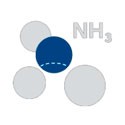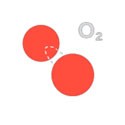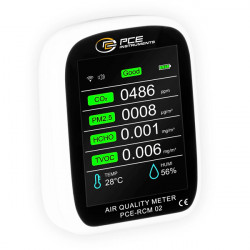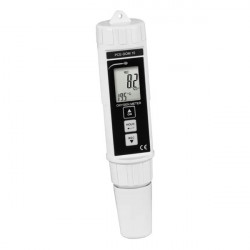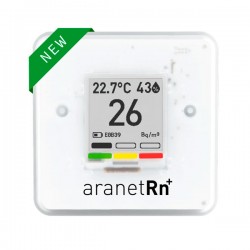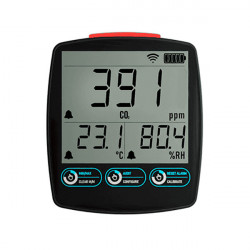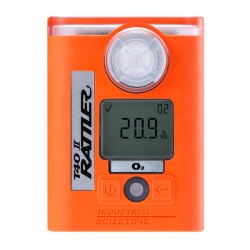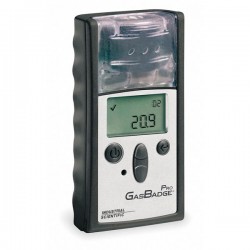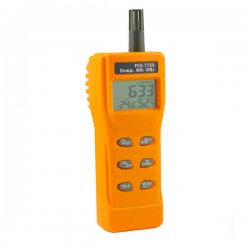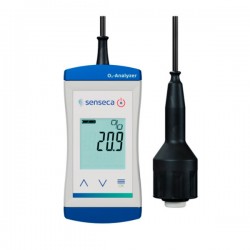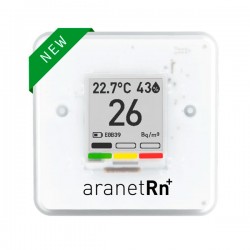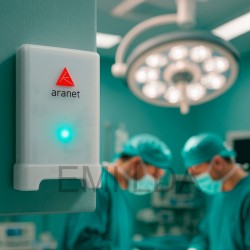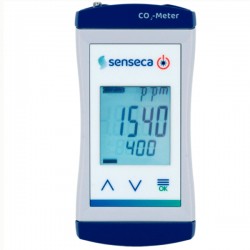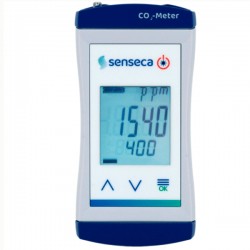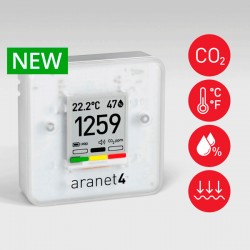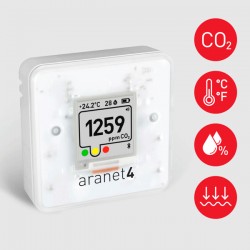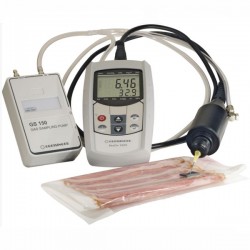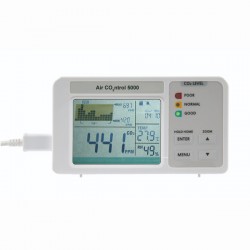No products
Prices are tax excluded
Gas Detectors and Analyzers
New products
-

Submersible Temperature Data Logger – Tinytag Aquatic 2 TG-4100
Tinytag Aquatic 2 TG-4100 – Submersible Temperature Data Logger Robust...
228,00€ -

-

Datalogger USB de Temperatura e Humidade EasyLog EL-USB-2-LCD+
EasyLog EL-USB-2-LCD+ – USB Temperature & Humidity Data Logger...
118,50€ -

Earth Ground Resistance Tester PCE-ERT 10
Earth Ground Resistance Tester PCE-ERT 10 The PCE-ERT 10 Ground...
198,90€ -

Handheld Vibration Meter PCE-VT 1100
Handheld Vibration Meter The PCE-VT 1100 handheld vibration meter is a...
291,90€ -

Energy Monitoring Module with Ethernet, Modbus Gateway and Data Logger - TCW260
Energy Monitoring Module The TCW260 is a high-performance energy...
283,70€ -

Ultrasonic Material Thickness Gauge Elcometer MTG8-TXC
Material Thickness Gauge The Elcometer MTG Ultrasonic Thickness Gauges...
2 449,00€ -

Sound Level Meter PCE-MSL 1
Product Description The PCE-MSL 1 sound level meter is a compact and...
36,90€ -

4G LTE Wireless I/O Module with MQTT - TCG120-4G
4G LTE Wireless I/O Module with MQTT Support The TCG120-4 is an...
269,70€ -

Industrial IoT module TCW242
Smart Ethernet controller for industrial automation The Industrial IoT...
225,10€ -

Ultrasonic Material Thickness Gauge Elcometer MTG6-TXC
Material Thickness Gauge The Elcometer MTG Ultrasonic Thickness Gauges...
1 930,00€ -

Particle Counter PCE-RCM 12
Product overview – PCE-RCM 12 particle counter The PCE-RCM 12 particle...
466,90€ -

Particle Meter PCE-RCM 02
Product Description The PCE-RCM 02 Particle Meter is an advanced,...
131,90€ -

Elcometer MTG Ultrasonic Material Thickness Gauge MTG2-TXC
Material Thickness Gauges The Elcometer MTG range delivers fast,...
1 126,00€ -

Mini Anemometer PCE-MAM 2
Product Overview The PCE-MAM 2 pocket-size mini anemometer delivers...
38,90€ -

Mini Thermo-Hygrometer PCE-444
Product Description The PCE-444 Mini Thermo-Hygrometer is a compact and...
38,90€ -

Infrared Thermometer - ScanTemp 355
Overview The ScanTemp 355 adds a circle laser sight and lets you read...
42,00€ -

Infrared Thermometer PCE-889B
Overview The PCE-889B infrared thermometer delivers fast, non-contact...
160,90€ -

Reliable IP Monitoring & Control for Sensors and I/O Poseidon2 3268
Poseidon2 3268 — Reliable IP Monitoring & Control for Sensors and...
458,70€ -

Temperature & Humidity Transmitter 4–20 mA — Ref. T3110
Temperature & Humidity Transmitter The T3110 is a temperature and...
225,00€ -

Ultrasonic Material Thickness Gauge Elcometer MTG4-TXC
Material Thickness Gauge The Elcometer MTG Ultrasonic Thickness Gauges...
1 450,00€ -

Stainless Steel Bench Scale 6 Kg — Ref.: FOB 6K2
Description The compact stainless steel bench scale with color-guided...
240,00€ -

Wall-Mount Temperature & Humidity Sensor HTemp-1Wire-Box2 | HW Group
HTemp-1Wire-Box2 Temperature & Humidity Sensor The HTemp-1Wire-Box2...
130,90€ -

Environmental gateway with LTE TDSBOB03
3-in-1 environmental gateway with LTE, PoE and IP67 The Aranet PRO Plus...
560,00€ -

Precision Balance 60 g | 440-21A
The 440-21A precision balance delivers fast, reliable weighing up to 60...
380,00€ -

Professional SNMP Device for Remote Environment Monitoring STE2 PLUS | HW Group
STE2 PLUS — Professional SNMP Thermometer for Remote Environment...
349,00€ -

Infrared Food Thermometer PCE-IR 100 (HACCP)
Description The PCE-IR 100 combines fast, hygienic non-contact infrared...
89,90€ -

Thermal Environment Meter PCE-WB 20SD
Overview The PCE-WB 20SD is a data-logging thermal environment meter...
560,90€ -

Thermal Environment Meter – PCE-WBGT 10
Thermal Environment Meter The PCE-WBGT 10 Thermal Environment Meter is...
137,90€ -

Data Logger with Display for Temperature, Humidity, Dew Point and Pressure
LOG220 PDF – Data Logger with Display for Temperature, Humidity, Dew...
97,00€ -

Environmental Meter — 5-in-1 PCE-EM 883
5 environmental parameters Sound level meter | Lux meter | Anemometer |...
222,90€ -

LAN & Wi-Fi Thermometer for Remote Monitoring | STE2 R2 — HW group
STE2 R2 — LAN & Wi-Fi Thermometer for Remote Monitoring STE2 R2...
294,00€ -

WiFi Remote Temperature Sensor with External Thermocouple – 21CFR
EL-WiFi-21CFR-TC | EasyLog The EL-WiFi-21CFR-TC is an advanced...
227,50€ -

Temperature and Humidity Mini Sensor TDSPT101
Aranet T/RH Mini Sensor Product Code: TDSPT101 Compact, wireless sensor...
80,00€ -

Digital Force Gauge PCE-FM 200
Tension and Compression Measurement up to 200 N The PCE-FM 200 digital...
351,90€ -

-

Oxygen Content in Liquids PCE-DOM 10
PCE-DOM 10 Water Analyzer The PCE-DOM 10 Water Analyzer is a...
284,90€ -

Professional Oven Thermometer with Flexible Metal Probe 14.1037
Key Features Accurate monitoring of cooking chamber temperature up to...
28,00€ -

Multilogger M1220 – Thermo-Hygrometer with 4 Inputs
Product Overview The Multilogger M1220 is a versatile universal...
765,00€ -

Aranet Radon Plus PRO – Advanced Indoor Air Quality Monitoring Radon Plus PRO TDSPSR02
Advanced Radon Indoor Air Quality Monitoring The Radon Plus PRO delivers...
249,00€ -

Temperature and Humidity Data Logger with Display LOG210 TC PDF
LOG210 TC PDF - Temperature and Humidity Data Logger The LOG210 TC PDF...
103,00€ -

Digital Refractometer for Alcohol Industry ORL 94AL
Digital Refractometer Specialized applications in the Alcohol Industry....
1 040,00€ -

Water Activity Meter PCE-WAT 10 Aw
Description The PCE-WAT 10 Water Activity Meter is a powerful device...
979,90€ -

Colour Spectrometer JCS 200
Versatile Colour Spectrometer for Professional Use The JCS 200 is a...
1 950,00€ -

Luxmeter with External Sensor SO 200K
High-Precision Luxmeter for Light Measurement up to 200,000 Lux The SO...
84,00€ -

-

Aranet 4xT-Probe Sensor TDSPT508
Accurate Multi-Point Temperature Monitoring The Aranet 4xT-Probe Sensor...
490,00€ -

Precision Thermometer LDT-450
Precision Thermometer Precision Thermometer LDT 450 — accurate and...
1 156,52€ -

CO2 Monitor with Built-in Carbon Dioxide Sensor - U8415
U8415 CO2 Monitor with Built-in Carbon Dioxide Sensor The U8415 CO2...
265,00€ -

Pt100 Temperature Immersion Probe Class 1/10 DIN | 6000-1084
Immersion Temperature Probe Explore the premium immersion probe designed...
210,00€ -

Precision Temperature Instrument T995
Precision Temperature Instrument The Series T900 process-controlled...
1 100,00€ -

Precision 4-Wire Pt100 Insertion Temperature Probe AX111-I3-B-150-L01-P-M12
Precision Insertion Temperature Probe The AX 111-I3-B-150-L01-P-M12...
61,00€
EMI, LDA, Edifício Estoril Office, Av. República 3000A, Esc. 19A, 2649-517 Alcabideche PORTUGAL
EMI LDA offers the gas detection systems for early detection and prevention of Gas Detection. Measurement and detection of combustible and refrigerant gases.
Gas Detectors and Analyzers There are 26 products.
Subcategories
O2/ CO2/ CO
Carbon dioxide measurement is required in many applications from building automation and greenhouses to life science and safety.
CARBON DIOXIDE AND SAFETY
Carbon dioxide is a non-toxic and non-flammable gas. However, exposure to elevated concentrations can induce a risk to life. Whenever CO2 gas or dry ice is used, produced, shipped, or stored, CO2 concentration can rise to dangerously high levels. Because CO2 is odorless and colorless, leakages are impossible to detect, meaning proper sensors are needed to help ensure the safety of personnel.
Effect of Different Levels of CO2Concentration Effect 350 to 450 ppm Typical atmospheric concentration 600 to 800 ppm Acceptable indoor air quality 1,000 ppm Tolerable indoor air quality 5,000 ppm Average exposure limit over 8-hour period 6,000 to 30,000 ppm Concern, short exposure only 3 to 8% Increased respiration rate, headache > 10% Nausea, vomiting, unconsciousness > 20% Rapid unconsciousness, death Ammonia NH3
Description
- Colorless combustible toxic gas with a characteristic pungent smell.
- Lighter than air, density = 0,73 kg/m3
- Lower explosive limit (LEL) = 15 %vol
Health exposure limits (Directive 2000/39/EC):
- 8 hours TWA = 20 ppm (14 mg/m3)
- 15 mins STEL = 50 ppm (36 mg/m3)
A colorless gas, highly soluble in water, with a characteristic pungent smell. Ammonia is a large-scale production of the chemical industry widely used as a raw material for the production of fertilizers and explosives,as a refrigerant,as a cleaning and antimicrobial agent. Ammonia is also produced naturally from the decomposition of organic matter, including plants and animals.
Carbon Monoxide CO
Description
Colorless, odorless and tasteless gas that is toxic to humans in concentrations above about 35 ppm. Lighter than air.
- Density at 0 °C = 1,250 kg/m3
- Density at 25 °C = 1,145 kg/m3
- Lower explosive limit (LEL) = 12,5 %vol
Health exposure limits (Directive 2000/39/EC):
- 8 hours TWA = 20 ppm (23 mg/m3)
- 15 mins STEL = 100 ppm (115 mg/m3)
Carbon monoxide (CO) has anthropogenic origins in the incomplete combustion of fossil fuels or other carbon-containing organic matter. It arises in emissions from electricity production, industrial, commercial or residential combustion and also from transport with combustion engines. It can also have natural origins in volcanic eruptions and forest fires.
In urban areas, road transport is the main source of CO and as such the concentrations of this pollutant vary with traffic variations. Furthermore, this pollutant is emitted in greater quantities when engines are at high speed, that is, when stopping and starting or at low speeds.
CO can cause headache, dizziness and malaise even nausea and vomiting, it can even reduce the ability to learn, work and manual dexterity. The harmful effects on human health are due to its ability to irreversibly combine with blood hemoglobin which, instead of binding to oxygen in the lungs to transport it to tissues and carbon dioxide to transport it from tissues to lung tissues, this function is compromised by the occupation of the hemoglobin position by CO, which creates a very stable composition. With long exposure times it can even cause death.
CO contributes to the formation of tropospheric ozone and its oxidation by oxygen in the air contributes to the greenhouse effect.
Oxygen O2
Description
- Colorless and odorless gas.
- Oxygen is 1,1 times heavier than air.
- Oxygen deficiency (less than 19% O2) is dangerous to human health.
A colorless gas, one of the main components of the air.Oxygen is necessary for the breathing of humans and animals, oxygen deficiency is harmful to health.
Oxygen: Oxidizing Gas for Life Support and Performance Optimization Applications
Oxygen is a colorless, odorless and highly reactive diatomic gas, constituting one of the main components of the Earth's atmosphere, with an approximate concentration of 21%. It is the most abundant chemical element in the Earth's crust, predominantly present in the form of oxides, silicates and carbonates.
In addition to its fundamental role as a breathing gas in medical and life support environments, oxygen has significant oxidizing properties that are exploited in multiple industrial sectors. Its use, in oxygen enrichment processes or partial replacement of atmospheric air, results in substantial gains in efficiency, allowing the optimization of chemical and biological processes, as well as improving performance and reducing the carbon footprint, when compared to sources alternative energy sources.
The main industrial applications of oxygen include combustion and oxidation processes, biological fermentation, wastewater treatment, and aquaculture systems. In the metallurgical industry, oxygen is widely used in combination with gases such as acetylene (C₂H₂), other fuels or with argon (Ar) and carbon dioxide (CO₂) for metal cutting and welding operations, brazing, scarifying, thermal hardening, cleaning and casting. In the food sector, oxygen is used to preserve the color and freshness of perishable products, such as meat, by maintaining a controlled gaseous environment.
Radon
Radon
Radon is a naturally occurring radioactive gas that is colorless and odorless. Its presence in the environment is common, both outdoors and indoors. However, prolonged exposure to radon inside buildings poses a significant risk to public health.
Inhalation of radon is the primary source of ionizing radiation exposure for the general population, contributing over 40% to the annual effective dose of radiation received. The percentage of the annual dose received by the global population can be found in the report "Sources and Effects of Ionizing Radiation, UNSCEAR 2008 Report, Vol. I."
Exposure and Health Effects
Prolonged exposure to radon indoors is one of the leading causes of lung cancer. Smokers and ex-smokers are at an increased risk due to the combined action of tobacco and radon. There is no consistent evidence linking radon exposure to other types of cancer or diseases.Radon produces radioactive particles in the air we breathe. These particles become trapped in our respiratory pathways, where they emit radiation, causing damage to the lungs. This damage increases the risk of lung cancer with prolonged exposure over time.
According to the World Health Organization (WHO), it is estimated that radon exposure causes between 3% and 14% of lung cancer cases globally. In Europe, it is estimated that 9% of lung cancer deaths are attributed to radon exposure, representing about 2% of all cancer-related deaths.
Radon is present everywhere, both outdoors and indoors in buildings. All buildings contain radon, and in most cases, the concentrations are low.
In Portugal, certain areas of the country are more prone to higher levels of radon in buildings. These areas can be consulted on the radon susceptibility map. The map, produced from a national survey and the national radon monitoring campaign, indicates the level of susceptibility to radon indoors. However, the only way to know the exact radon concentration is by direct measurement.
Radon Presence and Monitoring
Although radon is present both outdoors and indoors in buildings, its concentration can vary significantly. Most buildings have low concentrations, but there are specific geographic areas where radon levels may be higher.The only way to determine the exact radon concentration in a building is through direct measurements.
Mitigation of Radon Exposure
Reducing exposure to radon indoors can be achieved through preventive measures implemented during the construction phase of new buildings or through corrective or remediation measures in existing buildings.
Particle Meter PCE-RCM 02
Product Description The PCE-RCM 02 Particle Meter is an advanced, reliable solution for continuously monitoring indoor air quality in homes, offices, commercial spaces and public buildings. Its compact size, modern design and intuitive operation make it suitable for both professional and everyday users.
131,90€Oxygen Content in Liquids PCE-DOM 10
PCE-DOM 10 Water Analyzer The PCE-DOM 10 Water Analyzer is a high-precision device designed to measure dissolved oxygen levels in liquids efficiently. Equipped with interchangeable sensors and automatic temperature compensation, it delivers reliable and accurate readings even under varying temperature conditions, making it perfect for on-site and mobile...
284,90€Aranet Radon Plus PRO – Advanced Indoor...
Advanced Radon Indoor Air Quality Monitoring The Radon Plus PRO delivers real-time measurements of radon gas concentration, temperature, and relative humidity, ensuring accurate monitoring of critical indoor air quality parameters.
249,00€CO2 Monitor with Built-in Carbon Dioxide...
U8415 CO2 Monitor with Built-in Carbon Dioxide Sensor The U8415 CO2 monitor is a reliable device designed to accurately measure indoor carbon dioxide levels. Although CO2 is colorless and odorless, elevated concentrations can lead to fatigue and reduced mental focus, impacting comfort and productivity.
265,00€CO2 and Air Quality Data Logger
EasyLog | EL-IOT-CO2 Easily monitor carbon dioxide levels and air quality with the advanced EasyLog EL-IOT-CO2 data logger. Perfect for homes, workplaces, schools, and horticultural applications, this device delivers precision, reliability, and innovative connectivity.
196,90€ATEX Single-Gas Detector T40 II Rattler – O2
ATEX Single-Gas Detector – O2 The T40 Rattler is a portable ATEX-certified single-gas detector designed to monitor oxygen (O2). This robust, lightweight, and highly reliable device stands out for its excellent technical performance and cost-efficiency.
207,00€Portable Oxygen Detector - GasBadge® Pro –...
Product Description The GasBadge® Pro by Industrial Scientific is a high-performance portable gas monitor engineered for lifetime protection against oxygen-deficient environments. Rugged and reliable, it integrates intelligent sensor technology, infrared communication, and market-leading safety features to ensure maximum operational safety.
591,00€CO and CO₂ Meter PCE-COG 10
The PCE-COG 10 is a professional, portable CO and CO₂ meter With 5,000 data-set memory, built-in CO, CO₂, temperature and humidity measurement, and direct CSV export. It is designed for indoor air quality (IAQ) audits, occupational safety, and ventilation control in offices, schools, healthcare, hospitality, and retail environments.
294,90€CO₂ Meter – Accurate Indoor Air Quality...
PCE‑7755 Portable CO2 Meter – Professional Air Quality Monitoring Brand: PCE The PCE‑7755 CO2 Meter is the ideal solution for accurately monitoring indoor air quality, providing simultaneous readings of CO2, temperature, and relative humidity.
232,90€O₂ Analyser / air oxygen meter (formerly G...
ECO 410(T)-MAX – O₂ Analyzer / Air Oxygen Meter Brand: Senseca High accuracy, durability and outstanding value for reliable oxygen measurements in a wide range of applications.
234,90€Aranet Radon sensor Aranet Radon Plus PRO...
Brand: Aranet Radon Plus PRO – Advanced Indoor Air Quality Monitoring The Radon Plus PRO enables real-time measurement of radon gas concentration, temperature, and relative humidity. With a portable design, multi-year battery life, and cutting-edge technology, this device ensures convenience and reliability for continuous indoor air quality monitoring.
249,00€Aranet Air quality sensor - PM Particle...
Brand: Aranet The PM sensor is designed to monitor indoor or outdoor air pollution levels and protect against harmful particles (PM) present in the air. This device, part of the PRO sensor series, includes an Aranet Sub-GHz ISM band radio that wirelessly transmits sensor measurements to the Aranet PRO base station.
240,00€Ammonia Detector-Transmitter Evikon E2608-NH3
Brand: Evikon The E2608-NH3-E gas detector-transmitters with excellent repeatability, stability and long service life. The E2608 provides two independent analog outputs OUT1 and OUT2, user selectable to 4-20 mA or 0-10 V. RS485 Modbus RTU digital communication interface included allows easy instrument configuration and integration into various automation...
501,00€Compact CO2 Air Quality Meter, Senseca...
Marca: Senseca Air quality meter CO2 monitoring for professions subject to greater CO2 exposure. With the built-in CO2 dosimeter it indicates the TWA average of 8 hours or 15 minutes (STEL). The equipment is portable and includes a clip to attach to the belt. The battery has a battery life of up to 24 hours!
409,80€Compact CO2 Air Quality Meter, Senseca ECO...
Marca: Senseca Air quality meter CO2 monitoring for professions subject to greater CO2 exposure. With the built-in CO2 dosimeter it indicates the TWA average of 8 hours or 15 minutes (STEL). The equipment is portable and includes a clip to attach to the belt. The battery has a battery life of up to 24 hours!
395,90€Indoor Air Quality Monitor EL-WEM EasyLog...
Brand: Lascar Electronic EL-WEM continuously monitors indoor air quality, includes a colored status ring to display the IAQ level at a glance. EL-WEM automatically sends the data to the EasyLog Cloud, allowing to analyze the measurement of PM2.5 and PM10 particles, volatile organic compounds (VOC), temperature, humidity and pressure.
250,00€Aranet Indoor Air Quality CO2 Monitor...
Marca: Aranet Who breathes good air is healthier, happier and can do more. Headaches, dizziness and permanent fatigue are often due to a high concentration of CO₂ in the air. Aranet4 PRO monitor helps you monitor how stale and contaminated the air is in indoor spaces where many people are present such as in schools, offices and public buildings.
199,00€External combination probe for LOG220 E...
Brand: Dostmann Electronic External combination probe for LOG220 E with CO2, temperature, humidtiy and barometric pressue, 1,8m cable
162,00€LOG220E PDF data logger with display for...
Brand: DostmannDatalogger for measuring with internal temperature, humidity and atmospheric pressure sensors. External sensors available for measuring CO2, temperature, humidity and barometric pressure. Includes motion sensor. Integrated USB interface for connection to PC for automatic PDF creation, includes support for wall mounting.
133,00€Aranet Indoor Air Quality CO2 Monitor...
Marca: Aranet Who breathes good air is healthier, happier and can do more. Headaches, dizziness and permanent fatigue are often due to a high concentration of CO₂ in the air. Aranet4 monitor helps you monitor how stale and contaminated the air is in indoor spaces where many people are present such as in schools, offices and public buildings.
169,00€Indoor Air Quality CO2 Monitor AIRCO2NTROL...
Marca: TFA Dostmann Who breathes good air is healthier, happier and can do more. Headaches, dizziness and permanent fatigue are often due to a high concentration of CO₂ in the air. TFA's AIRCO2NTROL COACH CO2 monitor helps you monitor how stale and contaminated the air is in indoor spaces where many people are present such as in schools, offices and...
118,80€Waterproof Residual Oxygen Measuring...
Brand: GreisingerResidual oxygen measuring system (for gases with elevated CO2 percentage GOEL 370). The resOx 5695-H meter indicates residual oxygen over the range of 0.0 to 100.0 O2 or displayed in mmHg O2. These ready-to-use residual oxygen measuring systems with included gas pump ideal for the quality control of MAP food packaging and comparable...
1 583,74€AirControl 5000 CO2 instrument with data...
Brand: Dostmann ElectronicThe AirControl 5000 CO2 instrument with data logger features an easy to read, LCD display. Indicates CO2 over the range of 0 to 5000 ppm. Indicates the temperature, humidity and CO-concentration.
146,00€Precise Oxygen Measuring Device Senseca...
Brand: SensecaThe precise oxygen GMH3692 features an easy to read, LCD display. Indicates oxygen over the range of 0.0 to 100.0% O2 and an accuracy of ±0.1% ±1 digit.
255,50€



